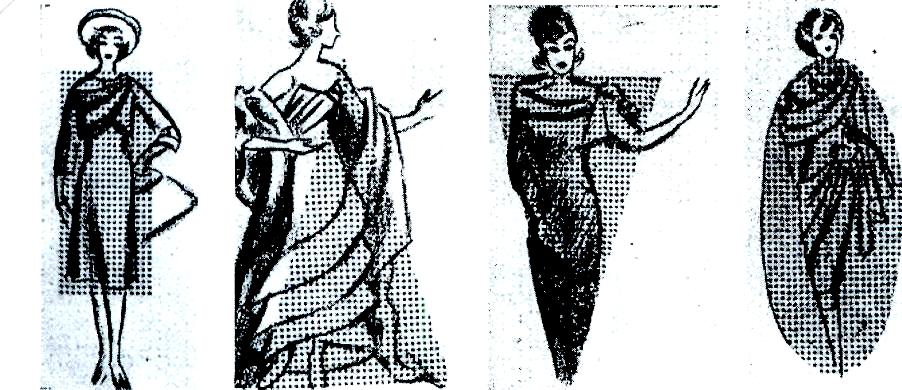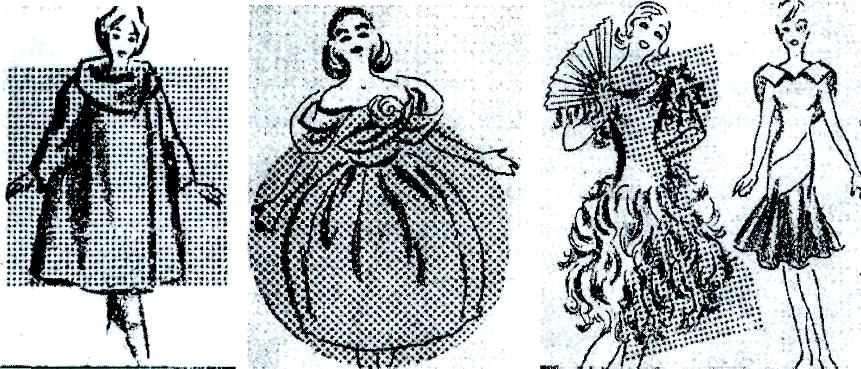
- •Шахты 2012
- •Содержание
- •Предисловие
- •Lesson One. Clothing and Textile Materials
- •Text a. Origin and Functions of Clothing
- •Vocabulary
- •Exercise 7. Say what you have learned from the text about:
- •Text b. Clothing, Costume and Dress
- •Vocabulary
- •Exercise 8. Read the text “Clothing, Costume and Dress” and translate in into Russian. Exercise 9. Fill in the blanks with the English equivalents of the Russian “платье”, “одежда”:
- •Distinctions among Clothing, Costume and Dress
- •Vocabulary
- •Lesson Two. Men’s and Women’s Clothing
- •Vocabulary
- •Text b. Caftan and Coat
- •Exercise 6. Read the text “Caftan and Coat” and think over the answers to the questions.
- •Vocabulary
- •Exercise 7. Complete the sentences using the text:
- •Exercise 8. Translate the reading selection given below. Reproduce the coloured version of the styles described.
- •Exercise 9. Say what you have learnt from the text about
- •Vocabulary
- •Lesson Three. Styles, Details and Silhouettes
- •Text a. Jacket Styles
- •Vocabulary
- •Text b. Parts of a Suit
- •Vocabulary
- •Exercise 7. Decide if the following statements are true or false.
- •Exercise 8. Look through the fashion magazines and watch tv programmes to describe updated suit styles offered by designers and worn by famous people (businessmen, politicians and so on).
- •Text c. Types of Fashion Silhouettes
- •Vocabulary
- •Lesson Four. Parts of Clothes
- •Text a. Sleeve Styles for Women’s Clothes
- •Vocabulary
- •Exercise 1. Read the text «Sleeve Styles for Women’s Clothes” to find the answers to the questions.
- •Exercise 2. Find and translate the sentences in which the following words are used. Determine what part of speech they belong to.
- •Exercise 3. Read the text once more for better understanding. Match the following descriptions 1-5 with the type of sleeve (a-e).
- •Exercise 4. Decide whether these sentences are true or false.
- •Exercise 5. Put the following words in order to make some questions for your partner.
- •Text b. Garments and their Parts
- •Vocabulary
- •Lesson Five. History of Garment Construction
- •Text a. Garment Construction
- •Vocabulary
- •Text b. Garment Construction
- •Vocabulary
- •Text c. History of Clothes and Design
- •Lesson Six. Clothes Design
- •Text a. Fashion Design
- •Vocabulary
- •Text b. Types of Fashion
- •Vocabulary
- •Vocabulary
- •Exercise 8. Read the text (several times) to better understand its contents. Answer the questions.
- •Lesson Seven. Elements and Types of Design
- •Text a. Elements of Design: Line and Form
- •Vocabulary
- •Text b. Elements of Design: Shapes
- •Vocabulary
- •Exercise 5. Return to the text “Elements of Design: Shapes” to decide whether the following statements are true or false.
- •Exercise 6. Translate the sentences paying attention to the word “one”.
- •Exercise 7. Choose the correct answer to match the shape of the garment and its description.
- •Text c. Elements and Types of Design
- •Text a. Fabric Trimmings
- •Vocabulary
- •Exercise 1. Return to the text “Trimmings” to answer the questions.
- •Exercise 2. Translate in writing the sentences with modal verbs can, may, must from the text. Exercise 3. Read the following sentences and translate them into Russian. Pay attention to the word wear.
- •Exercise 4. Read the dialogues and retell them in indirect speech.
- •Text b. Fashion Accessories
- •Vocabulary
- •Lesson Nine. Clothes and Technological Advances
- •Text a. Innovative Clothes
- •Vocabulary
- •Exercise 3. Translate the sentences with the infinitive constructions from a) into Russian and from b) into English.
- •Exercise 4. Write the summary of the text and reproduce it orally. Text b. Innovations in Fashion Design and Garment Production
- •Vocabulary
- •Exercise 5. Read the text “Innovations in Garment Production” several times to better understand its contents. Answer the questions.
- •Exercise 6. Find the English equivalents in the text:
- •Vocabulary
- •Lesson Ten
- •Text a. Techno Material
- •Vocabulary
- •Exercise 1. Return to the text “Techno Materials” to read it more attentively and answer the questions.
- •Exercise 2. Translate the sentences paying attention to the words with -ing.
- •Exercise 3. Write the summary of the text. Text b. Innovative Textiles
- •Vocabulary
- •Exercise 4. Read the text “Innovative Textiles” several times to better understand its contents. Exercise 5. Translate the words of the same root. State to what part of speech they belong:
- •Exercise 6. Rearrange the sentences to correspond the contents of the text.
- •Библиографический список
Vocabulary
arrangement n |
- |
размещение, расположение |
dimensions n |
- |
размеры, величина |
to enclose v |
- |
окружать, окаймлять |
to exaggerate v |
- |
преувеличивать, чрезмерно подчеркивать |
flexible adj |
- |
гибкий |
oblique adj |
- |
наклонный, косой |
raw materials |
- |
исходные материалы |
transition n |
- |
переход, перемещение |
to view v |
- |
рассматривать |
|
|
|
Exercise 1. Return to the text «Elements of Design: Line and Form” to read and translate the international words:
Elements, texture, principles, materials, form, illusion, horizontal, vertical, diagonal, decorative details, figure type, to characterize, radiation, analytically, balance, harmony, proportion, rhythm, special effect.
Exercise 2. Find in the text and translate into Russian in writing the definitions of a design, the principles and the elements.
Exercise 3. Read the text very carefully to answer the questions.
Does current fashion influence the elements and principles of design?
What is the function of line in designing clothes?
How are lines within a garment created?
Why are they called the greatest devices of fashion designers?
Is it possible to change visually the form of a human body with clothing?
Exercise 4. Respond to the statements orally.
Name the main principles of design.
Name the elements of design.
Name the lines used in making clothes.
Name the structural elements which create lines.
Name three dimensions which characterize form.
Reading for general understanding.
Text b. Elements of Design: Shapes
Shape describes the outer dimensions or contour of an object. Through clothing design, the shape of the human body is often revealed in a natural way, but sometimes may be distorted.
Every fashion period has a specific shape of garment which once determined can be modified and re-style in design without changing the basic shape of the garment, it is either flare or tight, circular or straight, a line or raglan. It is known that as easy fitting shape of the garment is easily accepted and largely varies as well as remains popular much longer than a tight-fitting garment.
In dress designing there are seven basic shapes – each season adaptations of one or more of these predominates the fashion picture. They are as follows:

Fig.1 Fig.2 Fig.3 Fig.4

Fig.5 Fig.6 Fig.7 Fig.8
1. Rectangle (Fig.1)
Long, straight, hanging in loose, graceful folds such as in Greek and Roman styles; straight line sheaths; tailored suits. Styles with these lines are slenderizing and suitable for the well proportioned, heavier woman.
2. Triangle (Fig. 2)
Examples: Spanish styles. Fitted bodice, bell shaped gently widening skirt.
3. Inverted triangle (Fig. 3)
Examples: Wide shoulders, narrow skirt, dolman or raglan sleeves. A suitable style for large bust.
4. Oval (Fig. 4)
Examples: Draped and softly molded, very feminine and decorative. Good for an ideal figure.
5. Square (Fig. 5)
Examples: Straight or boat shaped neckline, boxy jackets, capes. Good for the very thin figure, can camouflage various figure irregularities.
6. Round (Fig. 6)
Exapmles: Wide, crinoline lined skirts, petal shapes puffed sleeves. This fashion design is the most attractive on the very young and the very thin figure.
7. Hourglass (Fig. 7)
Examples: Wide shoulders, leg of mutton sleeves. Natural or wasp waist. Smooth fit over hips and full skirt at bottom. Good for the tall, thin figure.
8. Combinations
Examples: Outline of any current fashion silhouette can be altered and combined with another, and adapted for the specific figure type.
(to be continued)
